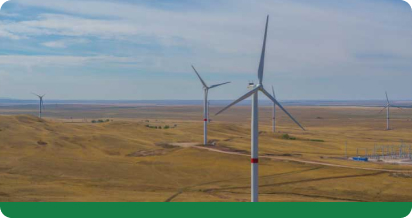We acknowledge our responsibility for complying with environmental standards in the regions of our presence and for environmental conservation. Therefore, we strive to improve our performance every day and are prepared to respond to future challenges and opportunities.
We engage in systematic efforts to interact with the population on environmental protection matters. We share the core principles of the precautionary approach (Principle 15 of the UN Rio Declaration on Environment and Development, 1992). Before commencing new projects and facilities, we conduct comprehensive Environmental Impact Assessment (EIA) to inform the public about the planned activities and their potential impact. This allows us to identify public opinions and to take them into account during the assessment process. We ensure that all stakeholders have access to draft EIA projects, including the acceptance and registration of comments and suggestions. Information is made available on local government websites and in the media to inform the public about planned measures.
According to the latest available data, the contribution of the Fund’s portfolio companies to direct greenhouse gas emissions nationwide is estimated at 14.7 %, with CO2 (carbon dioxide) emissions accounting for 15.6 % of the country’s CO2 emissions.
In 2022, the Fund Group’s carbon footprint (direct and indirect greenhouse gas emissions) was 60.9 million tonnes CO2-eq.6 However, the Fund’s carbon footprint data does not include installations not covered by the quota system, and indirect emissions data may not be complete due to a lack of reporting requirements for indirect emissions data.7.
Direct emissions were 50.7 million tonnes CO2-eq. GRI 305-1 Indirect emissions were 10.2 million tonnes CO2-eq. GRI 305-2 Direct emissions were 10.9 million tonnes CO2-eq below the 2021 level, and indirect emissions were 0.3 million tonnes CO2-eq below the 2021 figure. GRI 305-4 The greenhouse gas intensity indicator was 108.9 tons of CO2-eq. per million tenge of revenue, which is 27.5 % lower than in 2021. These changes are related to revision of methodology for calculation of methane emissions in the reporting year.8.
6According to the Concept of low-carbon development of the Fund, the carbon footprint in 2021 was 75 million tons of CO2-eq, which is associated with a more comprehensive coverage of the Concept of all sources of greenhouse gas emissions, as well as the use of a different methodology for calculating and accounting for methane emissions.
7Data presented for 2020, the Strategy for achieving carbon neutrality of the Republic of Kazakhstan by 2060
8Significant changes in the volume of greenhouse gas emissions are associated with a revision of the methodology and scope of calculation, in accordance with the Low-Carbon Development Concept of the Fund. According to the Concept of low-carbon development of the Fund, the carbon footprint in 2021 was 75 million tons of CO2-eq.
Direct CO2 (carbon dioxide) emissions decreased by 1.1 % from the 2021 level to 44.9 million tonnes CO2 (45.4 in 2021), which is a result of a number of initiatives to reduce greenhouse gas emissions.
The Kazakhstan Emissions Trading System covers 14 subsidiaries and affiliates of JSC NC KazMunayGas group (installation operators), which are included in the National Plan of Allocation of Greenhouse Gas Emissions Quotas. The operators of installations develop annual greenhouse gas inventory reports, which are subject to verification by an accredited independent organization. Quota installations have obligations to reduce greenhouse gas emissions under the national greenhouse gas emission trading system. Quota installations account for 34 million tonnes of CO2.
In accordance with the structure of the Fund activities, international requirements and guidelines for the disclosure of information on greenhouse gas emissions, the emissions are assessed in the following aspects:
- direct greenhouse gas emissions associated with the combustion of hydrocarbon fuels and substances, unavoidable volatile emissions (leaks), the operation of any production facilities and ongoing production processes — Scope 1 emissions (also for reporting purposes in accordance with the guidelines);
- indirect energy emissions related to the consumption of electricity, heat, hot water and steam supplied from outside — Scope 2 emissions;
- Scope 3 emissions – all other greenhouse gas emissions arising in the company’s value chain, namely emissions from the use of sold products (category 11 – Use of Sold Products). Portfolio Companies of the Fund, such as JSC NC KazMunayGas and JSC NAC Kazatomprom, are already calculating greenhouse gas emissions under Scope 3. JSC NC KazMunayGas discloses information on category No.11 “Use of Sold Products”. A phased development of Scope 3 reporting is also planned in other subsidiaries of the Fund.
Greenhouse gas emissions are calculated according to Order No. 280-п dated November 05, 2010 “On Approval of Some Greenhouse Gas Emissions Calculation Methodologies”, Order No. 9 of the Minister of Ecology and Natural Resources of the Republic of Kazakhstan dated January 17, 2023 “On Approval of Greenhouse Gas Emissions and Absorption Calculation Methodologies”, Order No.221 of the Minister of Energy of the Republic of Kazakhstan dated March 19, 2015 “On Approval of the Greenhouse Gas Inventory Monitoring and Control Rules”, Order No. 502 of the Acting Minister of Energy of the Republic of Kazakhstan dated July 28, 2015 “On Approval of Greenhouse Gas Inventory Report Forms”, Order No. 371 of the Minister of Ecology, Geology and Natural Resources of the Republic of Kazakhstan “On Approval of Greenhouse Gas Emissions and Absorption Calculation Methodologies” dated September 13, 2021, “Guidelines for IPCC National Greenhouse Gas Inventories”.
The main greenhouse gases issuers of the Fund are electricity and heat generation sector (54.2 %) and hydrocarbon exploration, extraction, transportation, refining sector (28.6 %). The scope of information disclosure on greenhouse gas emissions includes Portfolio Companies under the operational control of the Fund, and which are subject to national regulation in the field of greenhouse gas emissions of the Republic of Kazakhstan. The inventory boundaries did not include foreign assets, as well as Portfolio Companies under the financial control of the Fund. GRI 305-1 GRI 305-2
The main share of the consumed electricity of electricity and heat generation sector is produced using fossil fuels. As a result of fuel combustion, greenhouse gases enter the air, affecting climate change. In 2022, the volume of direct CO2 (carbon dioxide) emissions by the sector amounted to 32 million tons of CO2-eq, which is 3 % lower than in 2021. The volume of specific emissions also decreased by 0.02 million tons of CO2/million kWh as compared to 2021 and amounted to 0.8 million tons of CO2/million kWh.
The production activities of hydrocarbon exploration, extraction, transportation, refining sector is also related to the use of fossil fuels. In 2022, the volume of direct CO2 (carbon dioxide) emissions of the sector amounted to 9.8 million tons of CO2-eq. and increased by 3.1 % as compared to the indicator of 2021. The specific volume of greenhouse gas emissions by hydrocarbon exploration, extraction, transportation, refining sector amounted to 0.0003 million tons of CO2 per 1,000 tons of oil equivalent of CHC.
In 2018, JSC NC KazMunayGas announced its participation in the CDP initiative, an international community of investors to disclose information about direct and indirect greenhouse gas emissions and risks associated with climate change, including the assessment of the entire carbon footprint of commercial products from the well to its final use. In July 2022, the Climate Questionnaire of JSC NC KazMunayGas for 2021 was published on the CDP site, which includes data on the volumes of direct and indirect greenhouse gas emissions for all the company assets, including subsidiaries in Romania and Georgia. The CDP international climate rating is also in NAC Kazatomprom JSC’s plans for 2023.
The share of greenhouse gas emissions of the other subsidiaries is insignificant. The figures for all portfolio companies can be found in Annex 9.
We do not have significant emissions of ozone-depleting substances that affect climate change in our operations; therefore, this indicator is not consolidated at the Fund level. Periodic controls and monitoring are carried out. Climate change issues require risk identification and mitigation measures.



